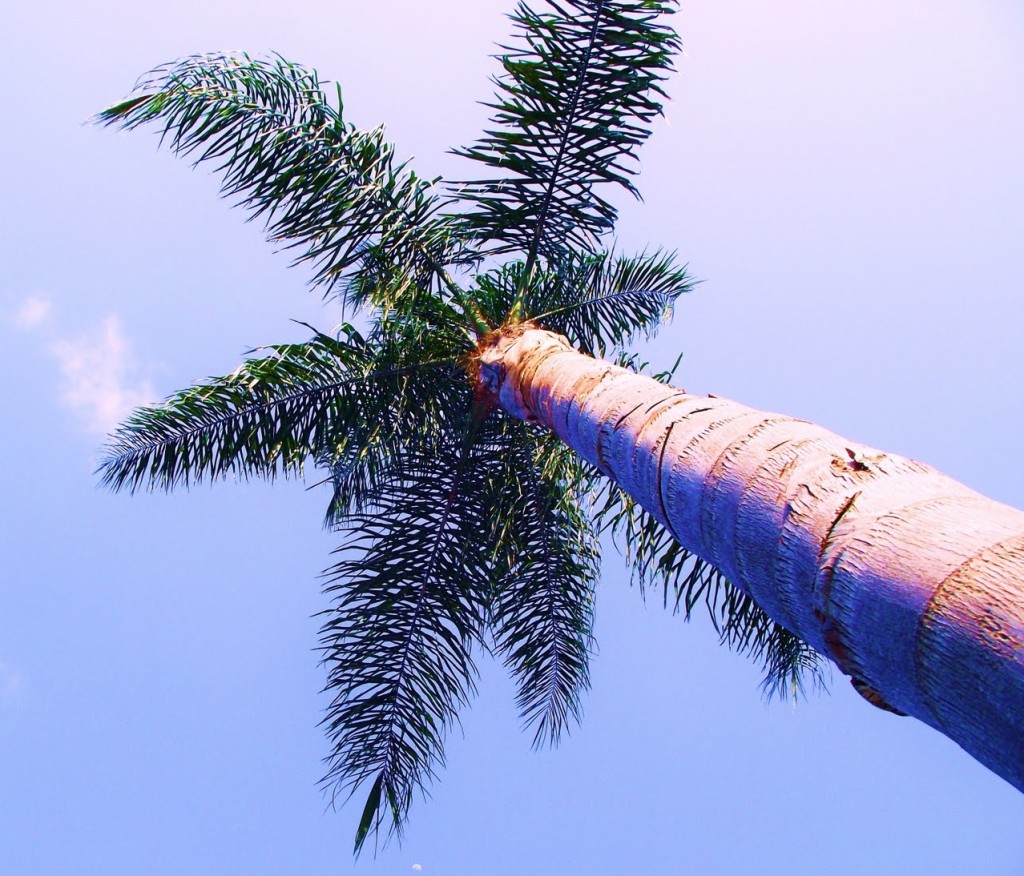
A forager’s typical view of a Queen Palm, photo by a White Washed Cottage
The Queen Palm and I got off on the wrong frond. Before I met one I had read it was toxic. There are a few toxic palms but the Queen Palm is not one of them.
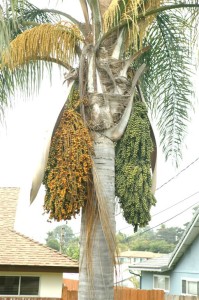
Fruit branches can be up to six feet long, photo by Hawaiian Dermatology
A rain forest native of Brazil, Paraguay and northern Argentina, Queen Palms, Syagrus Romanzoffiana, are more a landscaper’s delight than a forager’s. The palm is tall, stately, single-trunked with a crown of glossy, bright green, soft feather-like fonds. It forms a graceful, drooping 20-foot crown with bright orange fruit (dates) that favor ripening in the winter months but can be found at other times as well. They are popular adornments along streets or walkways usually planted every 15 feet. Their gray trunks are attractively ringed with dropped leaf scars. From Florida to California it is the most commonly planted palm. It’s also common in northern Australia and they’re easy to grow in pots indoors if you live in cooler areas.
The elements that make it a choice palm for landscaping makes it a headache for foragers. Unlike the much shorter and also edible Pindo Palm, the Queen Palm is usually too tall to harvest the dates easily. One is left to picking them up off the ground where they can develop a white mold. Aromatic and sweet the dates are sticky and fibrous with a very large seed. Usually you don’t eat the date meat but you can. One just chews on the pulpy coating getting the sugar off of it then spit out the fiber out. However, some people like to eat the fiber as well but it can cause a tummy ache in some people. Besides being loaded with simple carbohydrates the date has antioxidant qualities almost on par with vitamin C, according to a 2012 study.
From a landscaping point of view the palm while desirable is also a lot of work. They are not “self-cleaning” so the older fronds have to be removed (at just the right time or the palm suffers.) Also for many gardeners who turn a plot of land into a living painting a messy pile of orange dates is a visual blight on a highly coiffeured landscape. Thus the striking seed spikes are often cut off before the fruit gets a chance to ripen and drop.
The Queen Palm’s scientific name is a bit of a hodge-podge. When I first moved to Florida the palm was Cocos plumosa. Then it became a mouthful: Arecastrum romanzoffianum. Now it is the tongue twisting Syagrus Romanzoffiana (sigh-AY-gruss roe-man-zoff-ee-AY-nuh or see-A-grus ro-man-zof-fee-A-na) Though those and at least a half-a-dozen other names most people just called it the Queen Palm (or occasionally the Giriba palm.)
Syagrus (SEE-ah-grus) was a Greek poet who commented about Troy before Homer. Copycat references say the genus was named after the poet. That is Internet nonsense. On the Arabian seacoast there is a point called the Cape of Fartak, now in eastern Yeman, which is in the part of the world where dates were first cultivated and still grown. The ancient Greeks called it Cape Syagrus named after the σύαγρος (SEE-ah-gros) date. Greeks often named an area after what grew there. We also know the Roman author Pliny the Elder also referenced a Syagrus date. The genus is clearly named for the date not the poet.
Romanzoffiana is more obtuse. It honors Count Nikolai Petrovich Rumyantsev (1754-1826) which after going through the Dead Latin filter becomes Romanzoffiana. Who was he? Apparently a count you could not count on. Rumyantsev was a foreign minister to Alexander I of Russia. He sought closer ties between Russia and France in the early 1800s. Rumyantsev also, understandably, suffered a stroke when he heard that Napoleon had invaded Russia. Ooopse, slight miscalculation there. As a result of the stroke Rumyantsev lost his hearing and by then his career was in ruins. So why is a palm named after him? In private life Rumyantsev was a bit of a historian, collector of odds and ends, and patron of exploration voyages including the first Russian navigation around the globe. In short, he bought the honor. Nearly 200 years after his death all that remains of him is a painting and a palm.
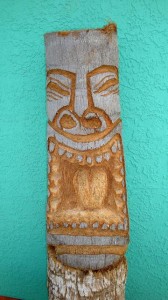
A Tiki made from a Queen Palm trunk. Photo by Tiki Room.
Curiously the University of Florida refers to the Queen Palm date as “ornamental” and classifies the palm as a category II invasive species. In Australia the palm is a threat to a bat called the Flying Fox. They eat the green dates and get sick. Also the large seed lodges behind their back teeth preventing them from eating thus starving. And the bats themselves get stuck in the fronds, which apparently throws off their radar. Despite that they do spread the seeds around causing it to be invasive there. In South America the seeds are spread by the tapir. In fact, in one study, which I would not have wanted to conduct, 98% of the tapir dung piles had Queen Palm seeds in them (averaging 200 seeds each.) That must be difficult to put on your resume: Tapir Dung Expert… Anyway, Queen Palms can hybridize with Pindo Palms producing some hard to identify palms and fruit. The hybrid species is called X Butiarecastrum. Why cross them? To get the grace of the Queen but the cold hardiness of the Pindo.
Green Deane’s “Itemized” Plant Profile.
IDENTIFICATION: An upright palm to 50 feet, pinnate compound leaves to three feet. Flowers white to cream, fruit green turning light orange then bright orange. Often you will see a palm with a bulge in the middle with a skinny trunk on bottom and top. That means it was neglected, then fed and watered well, then neglected again.
TIME OF YEAR: Fruits in late fall or the winter months
ENVIRONMENT: Acidic, well-drained sandy soil in full sun. Likes ample moisture and is slightly salt tolerant. Cold hardy to 20 F.
METHOD OF PREPARATION: The sticky, sweet pulp can be eaten off the seed, or made into wine or jelly. The seed oil is used for cooking. The palm’s inner pith dried might be a flour substitute.

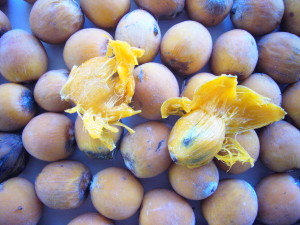
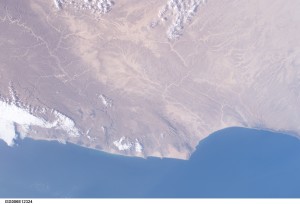


love the raw fruit, you should do a edible raw page similar to your edible flowers where they are grouped together. thank you for all your knowledge and willingness to put a page like this up
I attended your class in Meade Gardens a couple months ago and wrote down 40 names of plants you identified. Evidently I misspelled a number of them as I can’t find them on your blog.
Also, I can’t identify several plants near my house. May I suggest that you have a seminar, possibly regularly, to allow people (particularly rank beginners) bring specimens to be identified? Also, perhaps, to correct spelling?
Best regards,
Bob James
I’m doing fine with the thistles, sprouted Moranga,
Thanks for writing. My blog is very unforgiving for misspellings, which irritates even me as I am a poor speller. Might I suggest you first try them in Google which works on the principle that close is good and might produce the correct spelling you are looking for. A seminar is an interesting idea. The Winter Park library has a coffee shop and a little out door area. Maybe one could do a seminar there for a couple of hours.
i eat these all the time there quite good!
Can you eat the white coconut looking flesh inside the nut/seed?
I have, but it’s an awful lot of work for a tiny morsel of coconut. It tastes just like coconut. In many respects, the Queen Palm fruit is like a miniature coconut with the fibrous outer body and the little nut inside.
Purchased 4 of these at SAM’S this evening for $26 a piece,can’t wait to plant around my pool.Great article.
I don’t recommend planting these close to pools. I have two near my pool and the droppings from the blooms are a headache
I am new to Florida. This is the BEST website I have found for information.
Thank you so much for all your hard work.
How long can the juice of the queen palm be stored in the refrigerator before using it to make jelly? Thanks
Until mold starts. Better to freeze it.
HI,
I wondered if you could help me, I want to harvest the seeds from my Queen palms, but there seems to be different opinions on how it should be done. Some say the seeds should be taken out of the fleshy part while the fruit is still green ,then as much of the hairy outside taken of ,then 3 days in water,then in a sealed plastic bag in a warm area (I’m not sure),others say wait till the fruit is ripe (orange)and maybe even falls off by itself then start the same process,I’m not sure which is right. Also even though all the fruits are still green ,I found a lot of seeds on the ground around the trees,it seems they either fell of and dried out in a previous season or were eaten clean(some seem quite small,others like they are still in the process of drying). Can I do anything with these ,plant them in other words. I would really appreciate your help if you can.
Thanks
Ulrich
Plant them? Sure, but improving their germination is beyond my area of expertise.
Queen palms are not good landscape plans because they are prone to falling during a hurricane as reported in the book Stormscaping (Florida Gardening Series, Vol. 3) by Pamela Crawford.
I’ll chance it. I like the fruit.
Ours did fine during Irma. A lot of landscapers don’t dig deep enough when they plant palms. If there is a hard pan, that is as deep as the roots will go, so if the hard pan is 2 1/2 feet deep, but the landscaper only dug 2 feet, then the roots will be 2/12 feet deep, even if the tree is 30 feet tall. We saw them all over the place after the hurricane. Big palms with almost no root ball.
I had a Queen Palm at my house for over 50 years and it never had a problem with any hurricanes, it did die when the neighbor decided to put in a new fence and the pole hole full of cement was right next to it…
All of ours have held up to all the south florida hurricanes the past 20 years. The only ones we lost out of 10 were two due to severe lighting damage. Yet, our neighbor’s have lost a royal palm every year from lighting for the last 6 years. This year the poor tree was replaced twice.
Sounds like one to me. Got a picture?
Tough tree to look after when mature. Invades native forests. Fruit Bats have spread nuts into some of the most pristine rainforest left in Nth Queensland. They grow aggressively on the margins or at breaks in the canopy. Please no more for Nth Qld. Foxtail palms are a better choice for beauty but the fruit isn’t edible.
There is a very attractive variant called the Silver Queen. It has over 30 fronds and looks like a giant puff ball. It is also more cold resistant and grows to 80 feet. Mine has withstood 14°. Most of the fronds died but the tree survived easily. The fronds have a slight silvery color to them. All in all it is a more attractive and durable tree than the standard Queen Palm.
I am upset. We have/had a beautiful Queen Palm with seeds and all. It is taller than our house. Today my husband hired a man that came to our door to cut out the seed fronds. Not only did he cut those, but he cut them all but a few on the top of the tree. I can see how it will take several years before it will have those beautiful hanging fronds again. But my main concern is the health of our tree. I fear this will endanger our tree. What can I do to help it through the rest of this hot summer?
The queen will sprout every year at the same time. Don’t worry about the severe trimming, it is actually good for the tree. Ours can be trimmed back every year and the fruit still shows up on time!
Cutting off Green does not help palms. Look at palms in a natural setting. Those palms that are untouched will usually be the healthiest. A palm that is un touched can shade itself from the sun, feed itself by photosyntheses. and collect more water. Don’t cut green off a palm.
Small clarification here. Flying foxes don’t have the ability to echolocate. They are big diurnal bats (5-6ft wingspan) that find food by sight and smell.
What type of press is used to press the seed into oil?
There are several hand-operated seeds presses.
P lease help me. Can the nuts/seeds be used as live stock and poultry feeds and how can it be done.
further more i would like to know the nutrients in the seeds(nuts) which is helpful for both livestock and poultry. In my country the resident do not enjoy them as edible fruit
And can it serve the purpose of poultry and livestock with out pressing oil from them.
Are the fruits from all palms edible (and palatable)?
NO! Some have calcium oxalates in them which generally renders them not edible.
I noticed your comment that queen palms are common in northern Australia. They are also very common in the south as garden plants – not sure about in Tasmania though. I live in Perth and they are everywhere. My daughter’s large dog was fond of eating the fruit whole, it didn’t seem to do any harm but did have an interesting final outcome!
I can not find any recipes!!!! Any links or simple ways to jar/keep these little gems!?!
I have been experimenting with queen Palm fruits. My first attempt was fairly successful. I washed then boiled the fruits-about 2X volume of water to 1X volume of whole fruits. The fibrous fruit slowly softened off the nut-but was not completely removed, even when agitated. Maybe more water? Regardless I strained off the thick orange liquid and tossed the nuts. The liquid was sweet and smelled like pumpkin and apricots. I reached for the pumpkin pie spice, and added eggs and egg whites- cooking gently to form a rough custard. After pouring into custard cups and refrigerated. I did not add anything but eggs. They were DELICIOUS! I didn’t tell my family what was in them – topped with whipped cream-the only question was ‘is there more?’
My next attempts will include a more smooth flan, jelly, pie- maybe a cheesecake!
Thanks! Going to try the fruit. Hope my guts tolerate.
My neighbors have a lot of Queen palms along our mutual fence line. I recently noticed that my burros are eating the fallen fruit. Seeds and all. Do you know if this will hurt them? They are very crunchy and that is what caught my attention that they were eating them.
I have no specific information about that. The entire fruit, seed and all, are edible by humans though that does not hold true for equines (they cannot eat avocados for example.) My concern would be more along the lines of persimmons, which horses shouldn’t eat. They don’t digest it well and it forms a ball that has to be surgically removed from their gut. I think if I saw palm fruit fiber and seed husks in their manure that would be a sign things are going through well.
Are there people near Panama City, Florida who have knowledge of edible wild plants and also an interest in sharing what they know? I live near some genuinely rural pine forests and a number of spring fed ponds. Econfina Creek is near. There are plants of every type and description growing everywhere, and I can identify maybe five of them.
i dont like the mess the queen palm makes, so i cut the long spear off before it opens. will doing this harm it in any way if so could someone let me know. thank you.
Cautionary “tail”: I raise Labradors. We have an enormous park like yard & lots of various palms. The Segos were removed long ago: very toxic to pets. Labs eat everything in sight until they mature or are taught not to–if you are lucky. Some always see the world as a smorgasbord. Fortunately, when a 9 mo. old puppy ate a bunch, his smart system regurgitated the fibrous seeds back up over the next 12 hours. I think we were lucky. Pups, esp. Labs who eat anything & everything, should be protected from the fruit. It is very yummy. But the indigestible fibrous seeds could send a pup to the hospital or worse. So we cut the the fruit off our Queens long before they mature & fall. Our trees only produce fruit every several years.
How do you know when to cut before the fruit mature?
I was about to cut the fronds and Seed clusters from our two trees. Thanks to your website, I will harvest the fruit. We lost our dachshund because he kept eating the fruit seeda and all. He always coughed up the seeds until the last time. He would eat everything, aluminum cans, hard candy, chocolate and nothing bothered his system. He funally got a seed stuck while we slept. Lesson learned.
I’m so glad I found this blog!!! I need help with our palm. We have a 30 year old (I’m guessing based on the age of the house) Queen Palm outside our picture window, which we are very attached to. We’re guessing it’s 20-25ft. Today I noticed a little bark damage under two completely dried, dead fronds rubbing against the trunk in the winds. We weren’t planning to trim the fronds immediately, but now we might. We live in Phoenix, AZ, so very hot, dry, and sunny. Does the health of these palms suffer if the dead fronds aren’t trimmed? Also, are dead fronds at the base (lots of healthy green ones on top) normal or a sign of a problem? I wish I could post a pic. Thank you for any help!!
Nature does not trim dead fronds. They are not a problem to the palm.
In Florida I have a couple of Queen palms and they have been dropping fruit. I have fed them to my pet goats and they like them, funny as they chew off the meat and spit out the seed. Now there is so much dropping and starting to rot. I want to catch the dropped fruit on a tarp and would like to make a jelly or preserve from them. Any information on doing this would be appreciated.
Hi Jerry. I just started collecting ours. I tied a tarp around the tree and strung the edges up to catch the fruit. It seems to be working. I’m looking for a jelly recipe. Did you find one yet? Thanks.
Hello, I live near Galveston and have several types of palm trees in my yard. I got rid of the sego palms because I’m a dog owner and know how poisonous they are. Recently my dogs have been bringing me seeds that are dark brown with a golden yellow fiber inside. I have taken them out of their mouthes and tried to look them up. I have several Mexican Fan palms and Queen palms are in the adjacent yards and we have almost half acre yards. These seeds are almost an inch long and look like little coconuts. Is there any way I can send you a picture of this nut/seed/date? I really need to know because I really don’t feel safe letting my dogs out in the back with out me if these things are poisonous…note* This morning after eating a good breakfast, they brought me 2 of them. The hard dark brown skin was chewed off and the golden inside cracked. They like these! Plz help! TY, Teresa Sturrock from Texas!
Absolutely hilarious and fascinating! I am a Midwesterner going on my 7th week of an unplanned stay in Florida (not flying back due to COVID) and have become increasingly curious about all of the palms around here. I loved the background on the naming and will now look at the queen palm outside our door with much more appreciation!
Frondly,
Brittany
I have an oil press that can handle a seed the size of the Queen palm nut. My question is what time in the pod or seed cluster production is best to harvest? (1) as the nuts turn orange cut the pods off and shake the nuts onto tarps ready for pressing. (2) placing tarps under trees to capture seeds as they fall of the trees. (3) either way the seeds need to be rinsed to wash dust and debris allowing drainage and air drying before feeding into hopper of oil press.
can you kidly post details as to how queen palm is different from coconut plumosa. by what age queen palm starts yielding fruits. do they yield in particular season or round the year.
Thank you for sharing such interesting information on this Queen Palm. Last year was the first time I came to realize the seed were edible. Of course i tasted a fruit and was amazed how tasty it was. I ended up making juice and freezing after researching. i am now harvesting this year’s crop. I will be making the custard that was shared by one of your many students. Keep up the good work.
I have three large Queen Palm trees in my yard. I’ve not had them trimmed yet, this year nor their seed pods. I now have gallons of fruit if I want them. I gathered a nice bunch of them today to experiment. Warning. You can get a pulp like liquid from them, but it’s very thick and sticky. Can anyone here tell me how I can thin it out, so it’s more usable? It smells weird, but tastes like a sweet banana with a nutty hint. I took on too many this time around, but I don’t want to give up yet. I simmer them in water for an hour, but I didn’t them them cool long enough. Maybe that’s why it was so thick? Any information you all can provide would be much appreciated. I’d really like to come up with a jelly. I’m no jelly maker, but I’m hoping someone here will have an idea or even a good recipe. Thanks in advance, I’ll be waiting. =]
Can the green fruits ripen off of the tree?
I don’t think so.